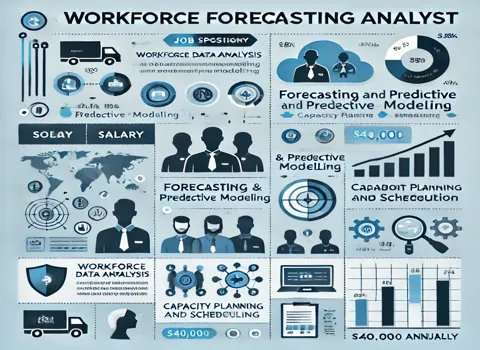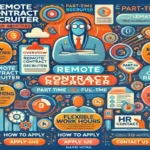Workforce Forecasting Analyst (Remote)
Annual Salary: $40,000
Position Overview:
We seek a detail-oriented and analytical Workforce Forecasting Analyst to join our remote team. The ideal candidate will analyze workforce data, develop accurate forecasting models, and provide actionable insights to ensure operational efficiency in workforce management. This role is crucial for optimizing staffing levels, predicting workload demand, and driving data-driven decisions that impact the business’s bottom line.
In this role, you will collaborate with various departments, including HR, Operations, and Finance, to assess current and future staffing needs. By understanding patterns, trends, and the factors influencing workforce requirements, you will help guide resource allocation strategies that optimize productivity, cost management, and service delivery.
Key Responsibilities:
- Workforce Data Analysis:
- Collect and analyze workforce-related data, including historical performance metrics, attrition rates, hiring trends, and business forecasts.
- Monitor and interpret key performance indicators (KPIs) related to workforce management, such as productivity rates, staffing levels, and overtime.
- Ensure data accuracy and consistency by implementing rigorous quality checks and cleansing techniques.
- Forecasting and Predictive Modeling:
- Build and maintain statistical forecasting models to predict future workforce needs based on business growth, seasonality, and market trends.
- Use advanced tools such as Excel, statistical software (e.g., SPSS, SAS), and workforce management systems (e.g., NICE, Verint) to create accurate and timely forecasts.
- Regularly update forecasting models to reflect real-time changes in business dynamics and workforce requirements.
- Capacity Planning and Scheduling:
- Develop workforce capacity plans by assessing the availability and allocation of human resources across different departments.
- Work closely with team leads and department managers to align workforce scheduling with expected demand, ensuring sufficient coverage while minimizing overstaffing.
- Monitor the efficiency of current scheduling practices and recommend improvements to optimize productivity and reduce operational costs.
- Collaboration and Communication:
- Act as a liaison between workforce management and other departments, including HR, Operations, and Finance, to ensure alignment on staffing strategies.
- Based on data insights and analysis, provide recommendations on staffing levels, hiring timelines, and workforce optimization strategies.
- Present workforce forecasting reports, models, and recommendations to senior management and stakeholders in a clear, concise, and actionable format.
- Continuous Improvement:
- Keep up-to-date with industry best practices, tools, and technologies in workforce forecasting and management.
- Continuously refine forecasting methodologies and processes to improve accuracy and adapt to changing business environments.
- Identify opportunities to enhance workforce forecasting capabilities through automation, new tools, or more effective data collection methods.
- Risk Management:
- Identify risks related to workforce shortages, surpluses, or inefficiencies and develop contingency plans to mitigate these risks.
- Collaborate with HR to develop strategies for managing sudden changes in workforce demand due to external factors such as economic shifts or unexpected events.
- Reporting and Documentation:
- Develop detailed reports that provide insights into workforce trends, productivity, and forecast accuracy.
- Maintain documentation of forecasting methods, models, and key assumptions to ensure transparency and replicability.
- Regularly update leadership on workforce performance, gaps, and optimization opportunities.
Required Skills and Qualifications:
- Educational Background:
A bachelor’s degree in Data Science, Statistics, Mathematics, Business, or Human Resources. Candidates with relevant experience in workforce planning, forecasting, or related fields may also be considered. - Analytical and Problem-Solving Skills:
Strong analytical skills with the ability to interpret complex datasets and derive actionable insights. A keen eye for detail and a passion for problem-solving are essential for this role. - Technical Skills:
Proficiency in data analysis tools such as Microsoft Excel, SQL, and statistical software (e.g., SPSS, SAS) is required. Experience with workforce management systems (e.g., NICE, Verint) is a plus. - Forecasting Expertise:
Experience developing statistical models, forecasting techniques, and predictive analytics in a workforce management context is highly desirable. Knowledge of demand planning and capacity management is also highly desirable. - Communication Skills:
Excellent verbal and written communication skills, with the ability to present complex data and insights clearly and concisely to stakeholders at all levels. - Attention to Detail:
High attention to detail with the ability to ensure the accuracy and consistency of data, reports, and forecasts. - Collaboration:
Ability to work effectively in a cross-functional team environment, collaborating with various departments to align on workforce strategies. - Time Management:
Strong organizational skills and the ability to prioritize tasks and manage multiple projects simultaneously in a fast-paced, remote work environment.
Preferred Qualifications:
- Prior experience in workforce management, operations, or business analytics in a contact center or service industry setting.
- Familiarity with automation tools and techniques to improve forecasting accuracy and efficiency.
- Knowledge of labor laws and regulations related to workforce management.
Work Environment:
This is a fully remote position, providing the flexibility to work from any location. The role may require occasional virtual meetings or collaboration with team members across different time zones. The ideal candidate must be comfortable with remote communication tools such as Zoom, Slack, and Microsoft Teams and demonstrate strong self-motivation and time management skills.
Career Growth:
As a workforce forecasting analyst, you will be pivotal in business decision-making. With demonstrated success in this role, you can advance to more senior workforce management, data analytics, or operations positions.
Compensation and Benefits:
- Annual Salary: $40,000
- Benefits include health insurance, paid time off, and opportunities for professional development.
If you are passionate about data analysis and workforce optimization and enjoy working in a dynamic remote environment, this role offers a challenging and rewarding opportunity.




